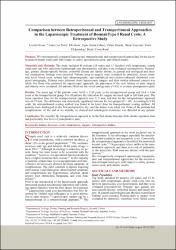| dc.contributor.author | Özcan, Levent | |
| dc.contributor.author | Polat, Emre Can | |
| dc.contributor.author | Önen, Efe | |
| dc.contributor.author | Cebeci, Oğuz Özden | |
| dc.contributor.author | Memik, Ömür | |
| dc.contributor.author | Voyvoda, Bekir | |
| dc.contributor.author | Ulukaradağ, Emre | |
| dc.contributor.author | Kara, Burak Yavuz | |
| dc.date.accessioned | 10.07.201910:49:13 | |
| dc.date.accessioned | 2019-07-10T19:36:35Z | |
| dc.date.available | 10.07.201910:49:14 | |
| dc.date.available | 2019-07-10T19:36:35Z | |
| dc.date.issued | 2015 | en_US |
| dc.identifier.citation | Özcan, L., Polat, E. C., Önen, E., Cebeci, O. Ö., Memik, Ö., Voyvoda, B. ... Kara, B. Y. (2015). Comparison between retroperitoneal and transperitoneal approaches in the laparoscopic treatment of Bosniak type I renal cysts: A retrospective study. Urology Journal, 12(4), 2218-2222. | en_US |
| dc.identifier.issn | 1735-1308 | |
| dc.identifier.uri | https://hdl.handle.net/20.500.12511/1205 | |
| dc.description.abstract | Purpose: We retrospectively compared laparoscopic transperitoneal and retroperitoneal approaches for the decortication of simple renal cysts with respect to safety, postoperative pain, and clinical results. Materials and Methods: The study included 40 patients (28 males and 12 females) with symptomatic simple renal cysts and who underwent laparoscopic cyst decortication, and they were evaluated retrospectively. Patients' age, gender, disease-specific history, comorbid disease and family history, in general and urological and physical examination findings were recorded. Patients prior to surgery were evaluated by urinalysis, serum creatinine level, blood count, urinary tract ultrasonography, and unenhanced and contrast-enhanced abdominal computed tomography. Patients were informed about laparoscopic surgery and their written informed consent was taken. For those who preferred the laparoscopic approach, the placement of the cyst, history of prior surgery and obesity were evaluated. All patients filled out the visual analog scale (VAS) to evaluate postoperative pain. Results: The mean age of the patients were 54.65 ± 5.26 years in the retroperitoneal group and 56.0 ± 4.66 years in the transperitoneal group. For all patients the indication for surgery included right or left flank pain. The mean operative time for the transperitoneal approach was 51.5 min, and that for the retroperitoneal approach was 44.75 min. This difference was statistically significant between the two groups (P <.05). According to VAS scale, the retroperitoneal scoring method was found to be lower than the transperitoneal scoring method. All patients were discharged on the first postoperative day, and the drains were taken out. None of the patients had complications. At the end of six months, no clinical and radiological recurrence was detected in any patient. Conclusion: We consider the retroperitoneal approach to be the first-choice because of its shorter operation time and particularly low level of postoperative pain. | en_US |
| dc.language.iso | eng | en_US |
| dc.publisher | Urology and Nephrology Research Centre | en_US |
| dc.rights | info:eu-repo/semantics/openAccess | en_US |
| dc.subject | Cystic | en_US |
| dc.subject | Kidney Diseases | en_US |
| dc.subject | Laparoscopy | en_US |
| dc.subject | Retrospective Studies | en_US |
| dc.subject | Surgery | en_US |
| dc.title | Comparison between retroperitoneal and transperitoneal approaches in the laparoscopic treatment of Bosniak type I renal cysts: A retrospective study | en_US |
| dc.type | article | en_US |
| dc.relation.ispartof | Urology Journal | en_US |
| dc.department | İstanbul Medipol Üniversitesi, Tıp Fakültesi, Cerrahi Tıp Bilimleri Bölümü, Üroloji Ana Bilim Dalı | en_US |
| dc.authorid | 0000-0001-5254-2563 | en_US |
| dc.identifier.volume | 12 | en_US |
| dc.identifier.issue | 4 | en_US |
| dc.identifier.startpage | 2218 | en_US |
| dc.identifier.endpage | 2222 | en_US |
| dc.relation.publicationcategory | Makale - Uluslararası Hakemli Dergi - Kurum Öğretim Elemanı | en_US |
| dc.identifier.wosquality | Q4 | en_US |
| dc.identifier.scopusquality | Q2 | en_US |


















